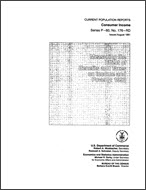Measuring the Effect of Benefits and Taxes on Income and Poverty: 1990
Measuring the Effect of Benefits and Taxes on Income and Poverty: 1990
Introduction
Traditionally, income and poverty data presented in Census Bureau reports have been based on the amount of money income received during a calendar year before any taxes and excluding capital gains. This definition of income is narrow and does not provide a completely satisfactory measure of the distribution of income. The omission of data on taxes, capital gains, and the value of noncash benefits has an effect on comparisons over time and between population subgroups.
The narrow income definition reflects the content of the March Current Population Survey questionnaire. The March questionnaire contains no questions about taxes and, until 1980, contained no questions about the receipt of noncash benefits. Since March 1980, the questionnaire has included items on the receipt of benefits from government programs (e.g., food stamps, housing assistance, Medicare, and Medicaid) and from employers (e.g., health insurance).
In the early 1980's the Census Bureau embarked on separate research programs to examine: 1) the effect of government noncash benefits on poverty and 2) the effect of taxes on income distributional measures. An expansion and integration of these research efforts led, in December 1988, to the publication of a report entitled Measuring the Effect of Benefits and Taxes on Income and Poverty: 1986 (Current Population Reports, Series P-60, No. 164-RD-1 ). That report presented calculations showing how income and poverty estimates changed when specific taxes were deducted and specific benefits were added to the income definition. This report presents updated estimates of the incremental effect of benefits and taxes on income and poverty for 1989 and 1990.
The 1989 estimates in this report differ from those published in Series P-60, No. 169-RD, Measuring the Effect of Benefits and Taxes on Income and Poverty: 1989. The 1989 Federal tax estimates in that report were based, in part, on 1988 IRS statistics, since 1989 IRS data were not available at that time. Both the 1989 and 1990 Federal tax estimates in this report are based on 1989 IRS statistics. For that reason, the 1990 Federal tax estimates in this report should be considered as preliminary.
A Note on Language
Census statistics date back to 1790 and reflect the growth and change of the United States. Past census reports contain some terms that today’s readers may consider obsolete and inappropriate. As part of our goal to be open and transparent with the public, we are improving access to all Census Bureau original publications and statistics, which serve as a guide to the nation's history.
Others in Series
Publication
Publication
Publication
Others in Series
Publication
Publication
Publication






